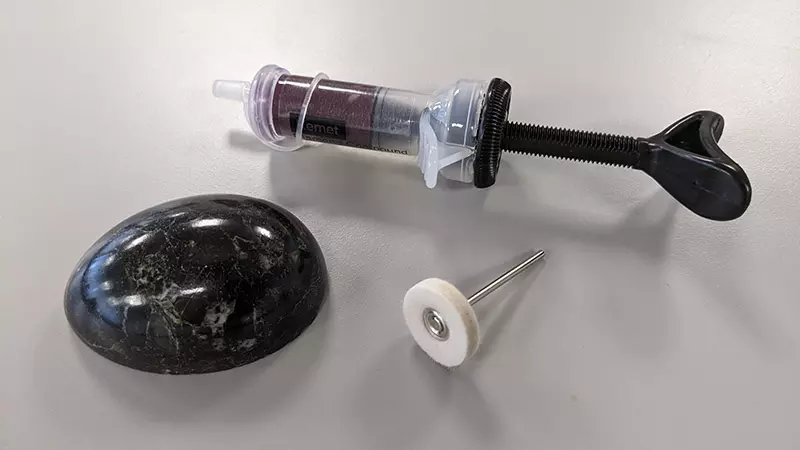Diamond Paste/Compound for Lapidary Polishing
Lapidary is the practise of crafting decorative objects, jewelry, and sculptures by cutting, shaping, and polishing various types of stones and hard materials. This craft necessitates specific techniques and tools, which is why many jewellers prefer to outsource lapidary work to specialists. Despite this, beginners can accomplish nearly every task that a full-scale lapidary unit can with a flex shaft or micromotor by using suitable attachments and polishing compounds. Diamond paste is a favoured option for lapidary polishing due to various reasons. To begin with, one of its remarkable qualities is the ability to effectively polish tough materials like corundum, quartz, and topaz, which can be difficult to work on with regular polishing compounds. Secondly, diamond paste can achieve a high level of polish on softer materials such as jade, lapis lazuli, and turquoise, which can be difficult to attain with traditional polishing compounds. Diamond paste offers a precise benefit to lapidary artists, as it enables them to achieve intricate designs and shapes with increased accuracy. The paste comprises of minute diamond particles that can access even the smallest fissures and corners of the surface undergoing polishing, culminating in an even and uniform surface appearance. This precision is particularly crucial in the creation of faceted gemstones, where angles and facets must be polished with high accuracy. Finally, diamond paste stands out for its exceptional durability and ability to maintain its effectiveness even after repeated use. Unlike traditional polishing compounds that wear out quickly and require frequent replacement, diamond paste can endure through multiple polishing sessions, making it a more economical choice in the long term.
Lapidary Polishing with Diamond Paste
A fast-running handpiece with diamond burs is typically used for drilling, followed by polishing with diamond compounds charged onto felt, wood, or leather attachments. The choice of polishing compound is critical and depends on factors such as the material being cut, its hardness, and the potential for staining or damage. Two main types of polishing compounds are available: water-soluble and oil-soluble. While water-soluble compounds work on most materials, they can cause rusting over time, making oil-soluble compounds a better choice for difficult-to-polish materials like rhyolite, ruby, and sapphire.
To initiate the lapidary polishing process, it is recommended to start with Diamond Compound Type L, which includes four micron grades: 45 and 25 for shaping, 14 for polishing, and 1 for a superior level of polish. To use the compound, mix it with lubricating fluid in a small dish to form a paste, soak the felt bob or wheel, and apply it to the stone's surface. Clean the stone with detergent and a soft brush each time you change grits to prevent scratching.
Proper storage and organisation of tools and compounds are crucial to avoid cross-contamination and prolong equipment longevity. Beginners can achieve professional results with the right attachments and polishing compounds, and Diamond Compound Sets are a great starting point for those who want to try lapidary work without investing in expensive equipment.

Which Gemstone Polish is Better: Diamond or Oxide?
When it comes to achieving a polished finish on natural gems, the question often arises as to whether oxide polish or diamond polish is the better choice. The selection of either abrasive depends on the desired outcome and the gemstone type being polished, although both abrasives can achieve a satisfactory polish.
Oxide polish is an abrasive made from aluminium oxide or cerium oxide and is commonly used in lapidary work. Its ability to produce a high-quality polish on a wide range of gemstones makes it a popular choice. The process usually entails the utilisation of a polishing wheel made of felt or leather, and may be executed either dry or with the incorporation of water or oil. One of the primary advantages of employing oxide polish lies in its adaptability, rendering it a fitting option for the polishing of an array of gemstones, including but not limited to opal, jasper, agate, and quartz.
In contrast, diamond polish is a more specialised abrasive composed of industrial-grade diamonds. This technique is frequently employed to polish more resilient gemstones, such as diamond, sapphire, and ruby. Different grit sizes of diamond polish are available, with smaller grit sizes resulting in a higher polish. Diamond polish is generally applied with a diamond paste or spray onto a polishing cloth or pad. Diamond polishing has an edge over oxide polishing as it can achieve a superior level of polish on tougher gemstones, which may pose a challenge for oxide polishing.
Deciding whether to use oxide polish or diamond polish is contingent on the desired outcome and the gemstone type being polished. When it comes to polishing gemstones, oxide polish is a budget-friendly and versatile option that can be used on a diverse range of stones, whereas diamond compound polish is a specialised abrasive that is reserved for harder gemstones that demand a more refined finish. Both types of abrasives have their advantages and disadvantages, and the selection should be made based on the specific requirements of the project at hand.
